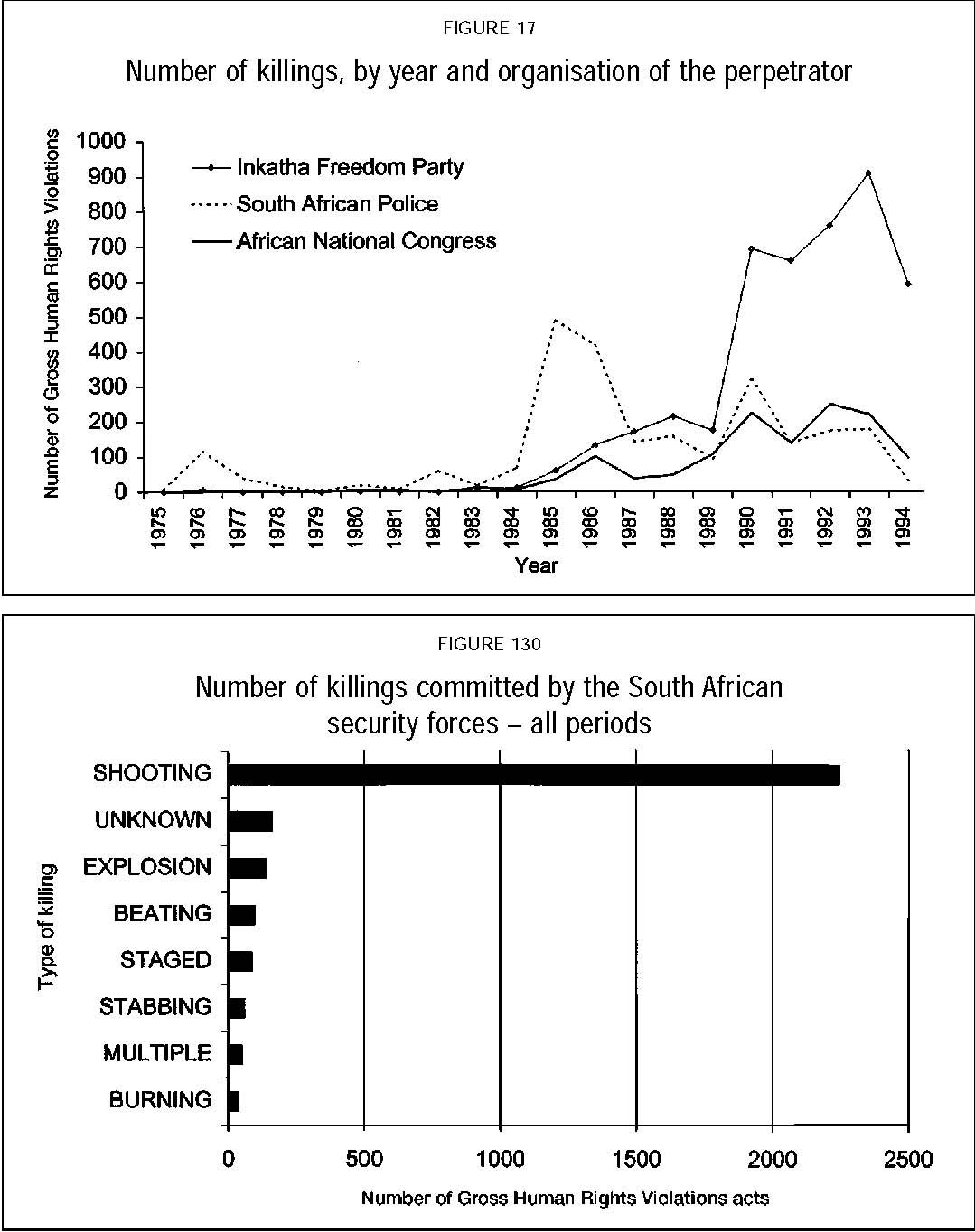 |
News | Sport | TV | Radio | Education | TV Licenses | Contact Us |
 |
News | Sport | TV | Radio | Education | TV Licenses | Contact Us |
TRC Final ReportPage Number (Original) 174 Paragraph Numbers 38 to 46 Volume 2 Chapter 3 Subsection 5 ■ PUBLIC ORDER POLICING38 The period under investigation by the Commission saw thousands of incidents of public disorder. Many of these incidents are extensively discussed in the following volume and elsewhere in this report. 39 The creation of a specialised riot control function within South Africa’s policing agencies was essentially a reaction to the disorder and political unrest arising from resistance to apartheid. Although the names and structures of the units tasked with this specialist function changed a number of times during the three decades under examination, and implementation devolved to various other policing agencies in homeland and self-governing territories, their roles remained the same – the enforcement of apartheid laws, the suppression of political protest and the prevention of ‘unrest, intimidation and unrest-related crimes’. 40 In the 1970s, as resistance to apartheid grew, the police began to see the need for a specialised capacity to ‘control unrest’. The SAP looked to international models and introduced new training methods and full-time riot control units. 41 The SAP was not equipped to deal with a domestic uprising of the scale they faced in June 1976. Police who faced massive protest marches at that time were ordinary officers drawn from nearby stations, with no special skills or training in crowd control. Their lack of capacity was reflected in their tendency to use maximum force. Minister of Police Jimmy Kruger reported at the cabinet meeting of 10 August 1976 that unrest in Soweto continued and that the children were “well-trained”.The Minister proposed that: “This movement must be broken, and the police should perhaps act a bit more drastically and harshly, bringing about more deaths.” [Commission translation.] This proposal was approved. 42 In a parliamentary discussion in July 1976 on the desirability of police wearing protective clothing in unrest situations, Jimmy Kruger responded: To have our police running around like knights of the Middle Ages, heavily armoured with coats-of-mail and visors, and goodness knows what else – policemen in such garb pursuing fleet-footed little Bantu all over the veld – is something I can hardly imagine. Not only would it be ridiculous, it is also completely unnecessary. In any case, a police officer will hardly be able to handle his rifle if he is also wearing a heavy flak jacket and a face guard. 43 During the 1980s, the riot policing function was expanded and separated from ‘normal’ police work, and resources were concentrated around what increasingly became a central police role. The first state of emergency was declared in 1985, and the National Security Management System (NSMS), established in 1979, fully activated in 1985/6. This provided a new context for riot control which was in line with the state’s highly militarised and co-ordinated approach to what was being described by the liberation movement as a ‘people’s war’. 44 Despite the expansion of its riot functions, the police had insufficient capacity to quell the rising levels of unrest. Operation Palmiet saw the deployment of SADF troops in a support capacity during the 1984 Vaal uprising. This deployment was later extended country-wide via Operation Xenon. However, it remained only a support capacity and the SAP retained primary responsibility for public order policing. 45 Figure 17 reflects a dramatic increase in the level of deaths attributed to the SAP in the 1984–86 period. As Figure 130 illustrates, killings by shooting form the overwhelming proportion of all deaths at the hands of the SAP. According to the Commission’s database, the majority of such shootings occurred during the course of public order policing.  46 A signal message containing the minutes of a meeting held in Pretoria on 2 May 1985 by the Joint Security Staff’s joint intelligence structure read as follows: Recommendation: proposed action against ringleaders i. The feeling of this GIS is that before a riot situation can be effectively defused, the ringleaders must be selectively eliminated ii. The idea around elimination is twofold: 1 The physical gunning-down of leaders in riot situations who make themselves guilty of Annexure 1 offences. 2 The removal of intimidators In the latter case specific thought is given to schools and labour situations. The feeling here is that when ringleaders are removed, they also need to be restricted physically, to such an extent that they are removed from circulation and kept away. [Commission translation.] |